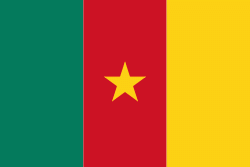Garoua-Boulaï (Garoua Boulaï)
Garoua-Boulaï (or Garoua-Boulay) is a town and commune in Cameroon. The town is on the border with the Central African Republic. Across the border, the nearest CAR settlement accessible by road is Baboua.
In 2014, the town was severely impacted by the number of refugees fleeing the Central African Republic. On 12 March 2014, IRIN reported: Some 30,000 refugees and returnees are estimated to have fled to East Region, where they are staying in the border towns of Garoua-Boulai, Kenzou and Yokadouma, living in squalid conditions, sleeping under trees, trucks and tents - some provided by the UN Refugee Agency (UNHCR), some cobbled together by refugees. Others have been taken into people’s homes - some of them relatives, some not. “Garoua-Boulai is overstrained by the different groups of refugees, and the situation is getting out of hand,” said the town’s mayor, Esther Yaffo Ndoe. “The refugees outweigh the capacity of UNHCR, the Red Cross and MSF, and the only government hospital is overwhelmed with patients,” she told IRIN ...
UNHCR and the Cameroon Red Cross (CRC) are registering refugees for transfer to a camp in Mborguéne, 50km from Garoua-Bulai, but the site is more or less devoid of basic services. There are just two wells and one school, which is not functional. The nearest health clinic is 27 km away from the camp. Getting it up to scratch will require a lot of work. Refugees are being "moved from Garoua Boulay to the new site at Mborguene, which can host up to 10,000 people."
As of April 2014, a spokesperson for UNHCR stated: The main entry points at Garoua Boulai and Kentzou [are] no longer accessible due to anti-Balaka activities, people are using alternative routes. “This has caused the number of entry points into Cameroon to grow from 12 to 27 over last three weeks, making it more challenging for our colleagues to monitor the border.”
In 2014, the town was severely impacted by the number of refugees fleeing the Central African Republic. On 12 March 2014, IRIN reported: Some 30,000 refugees and returnees are estimated to have fled to East Region, where they are staying in the border towns of Garoua-Boulai, Kenzou and Yokadouma, living in squalid conditions, sleeping under trees, trucks and tents - some provided by the UN Refugee Agency (UNHCR), some cobbled together by refugees. Others have been taken into people’s homes - some of them relatives, some not. “Garoua-Boulai is overstrained by the different groups of refugees, and the situation is getting out of hand,” said the town’s mayor, Esther Yaffo Ndoe. “The refugees outweigh the capacity of UNHCR, the Red Cross and MSF, and the only government hospital is overwhelmed with patients,” she told IRIN ...
UNHCR and the Cameroon Red Cross (CRC) are registering refugees for transfer to a camp in Mborguéne, 50km from Garoua-Bulai, but the site is more or less devoid of basic services. There are just two wells and one school, which is not functional. The nearest health clinic is 27 km away from the camp. Getting it up to scratch will require a lot of work. Refugees are being "moved from Garoua Boulay to the new site at Mborguene, which can host up to 10,000 people."
As of April 2014, a spokesperson for UNHCR stated: The main entry points at Garoua Boulai and Kentzou [are] no longer accessible due to anti-Balaka activities, people are using alternative routes. “This has caused the number of entry points into Cameroon to grow from 12 to 27 over last three weeks, making it more challenging for our colleagues to monitor the border.”
Map - Garoua-Boulaï (Garoua Boulaï)
Map
Country - Cameroon
 |
 |
| Flag of Cameroon | |
Early inhabitants of the territory included the Sao civilisation around Lake Chad, and the Baka hunter-gatherers in the southeastern rainforest. Portuguese explorers reached the coast in the 15th century and named the area Rio dos Camarões (Shrimp River), which became Cameroon in English. Fulani soldiers founded the Adamawa Emirate in the north in the 19th century, and various ethnic groups of the west and northwest established powerful chiefdoms and fondoms. Cameroon became a German colony in 1884 known as Kamerun. After World War I, it was divided between France and the United Kingdom as League of Nations mandates. The Union des Populations du Cameroun (UPC) political party advocated independence, but was outlawed by France in the 1950s, leading to the national liberation insurgency fought between French and UPC militant forces until early 1971. In 1960, the French-administered part of Cameroon became independent, as the Republic of Cameroun, under President Ahmadou Ahidjo. The southern part of British Cameroons federated with it in 1961 to form the Federal Republic of Cameroon. The federation was abandoned in 1972. The country was renamed the United Republic of Cameroon in 1972 and back to the Republic of Cameroon in 1984 by a presidential decree by president Paul Biya. Paul Biya, the incumbent president, has led the country since 1982 following Ahidjo's resignation; he previously held office as prime minister from 1975 on. Cameroon is governed as a Unitary Presidential Republic.
Currency / Language
| ISO | Currency | Symbol | Significant figures |
|---|---|---|---|
| XAF | Central African CFA franc | Fr | 0 |
| ISO | Language |
|---|---|
| EN | English language |
| FR | French language |















